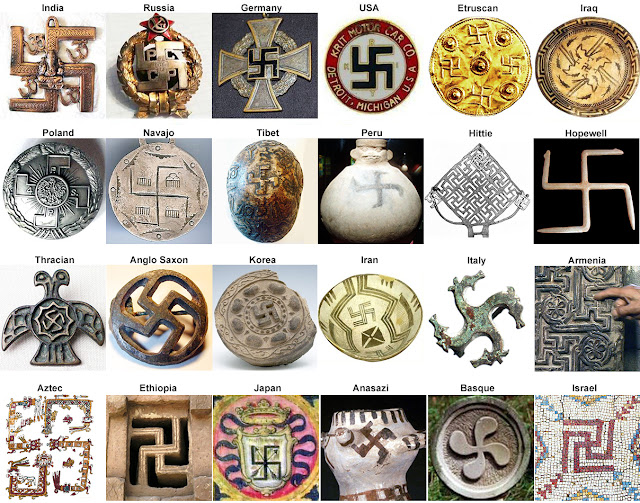 Merriam-Webster defines "symbol" as : an action, object, event, etc., that expresses or represents a particular idea or quality. We all know that, right? But who decides what a symbol represents? And how do we know that anyone else holds the same idea that we do in their own mind? This is a complicated question, which leads to layer upon layer of abstract concepts like cognitive psychology, sociology. and, depending how far down the rabbit hole you want to go, the nature of consciousness, perception and of reality itself.
Merriam-Webster defines "symbol" as : an action, object, event, etc., that expresses or represents a particular idea or quality. We all know that, right? But who decides what a symbol represents? And how do we know that anyone else holds the same idea that we do in their own mind? This is a complicated question, which leads to layer upon layer of abstract concepts like cognitive psychology, sociology. and, depending how far down the rabbit hole you want to go, the nature of consciousness, perception and of reality itself. Semiotics, one such rabbit hole, is the study of "the life of signs within a society." Consider the semiotic definition of signs (or symbols - for the intents and purposes of this blog) in which a sign inherently requires an interpretant in order to function as a sign. This definition, in loose layman's terms: A sign/symbol is what it is only because of association with something else, with which it has been determined to be associated by some person. Or even simpler: A sign means what the interpretant says it means. Okay, you may be thinking to yourself, "Thanks, Captain Obvious," but don't take this seeming simplicity for granted. Because symbols are defined by the interpretant, a translator, meanings of symbols, by nature, are mutable and interpretations are subject to bias. (See my previous entry about subjective reality).
But I am not writing to expound on the social acceptability of alphabetic characters. Let's turn to the real crux of my philosophical explorations.
Swastika: from the Sanskrit svastika, which means “good fortune” or “well-being." It is an important symbol in the Hindu faith and has been for thousands of years. In fact, this ancient symbol has been used by cultures all over the world, from Asia to the Americas and everywhere in between, to represent this same concept.
However, for many (possibly most) people in western culture today this symbol has become strongly aligned with an entirely different connotation, one of hatred, racism, genocide and just plain evil. I myself struggle to disentangle these opposing interpretations of the swastika, deeply rooted in my head. (Spending my formative, adolescent years with a father figure who was inappropriately fond of the hateful connections to the swastika probably doesn't help).
 |
| Reclaim the Swastika |
In march 2015, a student at George Washington University was suspended and temporarily evicted from campus housing pending investigation of an alleged hate crime. The act in question? A student, wishing to share what he had learned during a recent trip to India, about the origins of the sigil, posted a souvenir medallion in the shape of a swastika on the bulletin board of a fraternity house. He stood nearby to answer questions, but briefly stepped away, allowing a window of opportunity for fear and confusion to set in. To complicate matters, this same frat house had been very recently maliciously vandalized with spray painted swastikas.
Several organizations stepped up to help protect this student and defend his intentions, including the Foundation for Individual Rights in Education and the the Hindu American Foundation. After clarification of the events, GWU rescinded the student's suspension. Although many groups and individuals praised the school's administration for acting, in the end, on reason, there is still a representative group of people who maintain the opinion that the GWU student was only "mostly innocent" and must have intended to upset people, calling what he did a "fake hate crime" or a "hoax." This sort of narrow minded obstinance infuriates me. It implies that the religious significance of the Hindu swastika is at the very least irrelevant, the transparent excuse of a cowardly muckraker hiding behind a leftist stance of cultural tolerance, and at worst a patent lie, which denigrates entire cultures around the world.
 |
| http://atlanteangardens.blogspot.com/2014_06_01_archive.html |
The diversity of human culture, and the complexity of the human psyche precludes the possibility of ever eradicating such attitudes, which makes conflict and controversy inevitable. This thought brings me back to the idea of subjective reality and interpretation of symbols. We, as Homo sapiens, have distinguished ourselves from the neandertals by advancing our capacity for abstract thought, epitomized by language, math, art and religion. Of these, I believe art is the purest manifestation of that essential, human capacity. As such, art is also a manifestation of individual reality and subject to the mutability of interpretation. It is, and will always be, as equally volatile as the humans who make it. Ebullient and incendiary, exaltant and abhorrent, trivial and essential. If we seek to censor art, we seek to suppress the very nature of our own species, not only the weak, shameful, hurtful aspects of our nature, but also our nature to grow, to learn, to love and to evolve.
More:
What is Censorship? www.aclu.org
The Meaning and Significance of Swastika in Hinduism www.hinduwebsite.com
History of the Swastika www.ushmm.org US Holocaust Memmorial Museum
The Swastika Story: How an ancient sacred symbol became adopted by the Nazis www.hinduhumanrights,info
The Swastika: Ancient symbol of well-being struggles to overcome Nazi connections bharatabharati.wordpress.com
Swastika - Good luck emblem of ancient america mallstuffs.com

